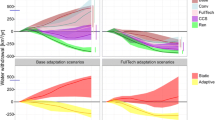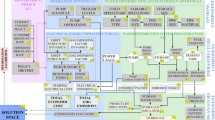Abstract
Water utilities generate greenhouse gas (GHG) emissions when they construct, retrofit, and operate their water distribution systems. The prospect of introducing carbon-abatement strategies such as carbon pricing and using low discount rates for project planning could potentially change the manner in which water utilities plan and design their drinking water systems. The objectives of this paper are to: (i) Review the current issues and controversies surrounding the choice of discounting rate and carbon prices in Canada to reduce the GHG emissions linked to operating water systems in Canada; (ii) Review previous research that has examined the impact of discounting and carbon pricing on design decisions in water supply and distribution systems, and; (iii) Illustrate the possible implications of carbon-abatement strategies (discounting and carbon pricing) on the design of Canadian water systems by way of a real-world case study. The implications of discount rate and carbon price uncertainty on water distribution system design are illustrated with the Amherstview-Odessa water transmission system in Ontario, Canada. The results of the Amherstview study indicated that lowering discount rate led to significant increases in electricity costs. The study results also suggested that for a sufficiently low discount rate of 1.4%, increasing carbon price led to a larger pipe size and pipe cost to offset carbon costs levied on fossil-fuel based electricity to operated the pumps for the life of the system. Additional studies are needed on large-scale water systems to inform decisions on system upgrades taken by water utility managers.




Similar content being viewed by others
References
Arrow KJ (1995) Intergenerational equity and the rate of discount in long-term social investment. IEA World Congress, Tunis
Boardman AE, Moore MA, Vining AR (2008) Social Discount Rates for Canada.” John Deutsch Institute Conference: Discount Rates for the Evaluation of Public Private Partnerships. Kingston, Ontario
British Columbia (B.C.) Government. (2008). Carbon Tax Act [B.C. Reg. 125/2008]. Queen’s Printer, Victoria.
Byatt I, Castles I, Goklany IM, Henderson D, Lawson N, McKitrick R, Morris J, Peacock J, Robinson C, Skidelsky R (2006) The stern review: a dual critique, Part II: economic aspects. World Econ 7(4):199–232
Carter RM, de Freitas CR, Goklany IM, Holland D, Lindzen RS (2006) The stern review: a dual critique, part I: the science. World Econ 7(4):165–198
CH2M Hill (2007) Fairfield water storage project final report prepared for loyalist township. Ottawa, Canada
Cline WR (1992) The economics of global warming. Institute for International Economics, Washington
Conceição P, Zhang Y, Bandura R (2007) Brief on discounting in the context of climate change economics. In: Human Development Report 2007/2008: Fighting climate change: human solidarity in a divided world. Human Development Report Office, United Nations Development Programme, New York, New York
Dasgupta P (2006) Comments on the Stern Review’s Economics of Climate Change. Prepared for a seminar on the Stern Review’s Economics of Climate Change, organised by the Foundation for Science and Technology at the Royal Society, London
Dietz S, Stern N (2008) Why economic analysis supports strong action on climate change: a response to the Stern Review’s critics. Rev Environ Econ Pol 2(1):94–113
Dougherty K (2006) Driving in Quebec likely to cost more. National Post, June 16
Downing TE, Anthoff D, Butterfield B, Ceronsky M, Grubb M, Guo J, Hepburn C (2005) Scoping uncertainty in the social cost of carbon. DEFRA, London
Environment Canada (2007) Regulatory Framework for Air Emissions. Library and Archives Cataloguing in Publication, ISBN 978-0-662-69717-6, Ottawa
Environment Canada (2008) Canada’s National Greenhouse Gas Inventory (1990–2006). Library and Archives Cataloguing in Publication, ISBN: 978-1-100-11176-6, Ottawa
Gollier C, Koundouri P, Pantelides T (2008) Declining discount rates: Economic justifications and implications for long-run policy. Economic Policy, October 2008, 757–795
Government of Quebec (2008) Quebec and climate change a challenge for the future: 2006–2012 action plan. Government of Quebec, Quebec City
Her Majesty’s Treasury (HMT) (2003) Appraisal and Evaluation in Central Government (The Green Book). Her Majesty’s Stationary Office, London
IPCC (2007a) Climate change 2007: the physical science basis. In: Solomon S, Qin D, Manning M, Chen Z, Marquis M, Averyt KB, Tignor M, Miller HL (eds) Contribution of Working Group I to the Fourth Assessment Report of the Intergovernmental Panel on Climate Change. Cambridge University Press, Cambridge
IPCC (2007b) Climate change 2007: mitigation of climate change. In: Metz B, Davidson O, Bosch P, Dave R, Meyer L (eds) Contribution of Working Group III to the Fourth Assessment Report of the Intergovernmental Panel on Climate Change. Cambridge University Press, Cambridge
Jenkins GP, Kuo CY (2007) The Economic Opportunity Cost of Capital for Canada – An Empirical Update. Queen’s Economics Department Working Paper No. 1133, July
Lee CF, Lee JC, Lee AC (2000) Statistics for business and economics. World Scientific Publishing Company, New Jersey
Lind RC (1990) Reassessing the Government’s discount rate policy in light of new theory and data in a world economy with a high degree of capital mobility. J Environ Econ Manag 18:S-8–S-28
MacLeod S, Roshani E, Filion Y (2010) Impact of Pipe Material Selection on Greenhouse Gas Mitigation in the Optimal Design of Water Networks Under Uncertain Discount Rates and Carbon Prices. Water Distribution System Analysis Symposium. Tucson, Arizona
National Round Table on the Environment and the Economy (NRTEE) (2007) Getting to 2050: Canada’s transition to a low-emission future. Library and Archives Canada Cataloguing in Publication, Ottawa
Nordhaus WD (2007) A review of the stern review on the economics of climate change. J Econ Lit, XLV, pp 682–702
O’Hara JK, Georgakakos KP (2008) Quantifying the urban water supply impacts of climate change. Water Resour Manag 22(10):1477–1497
Ontario Energy Board (OEB) (2008) Regulated price plan price report. Queens Printer for Ontario, Toronto
Pearce D, Groom B, Hepburn C, Koundouri P (2003) Valuing the future: recent advances in social discounting. World Econ 4(2):121–141
Rambaud C, Torrecilla MJM (2005) Some considerations on the social discount rate. Environ Sci Pol 8:343–355
Rao PK (2000) The economics of global climate change. M. E. Sharpe, Armonk
Rivers N (2010) “Impacts of climate policy on the competitiveness of Canadian industry: how big and how to mitigate?” Energ Econ 32(5):1092–1104
Roshani E, MacLeod S, Filion Y (2011) Evaluating climate change mitigation strategies on the optimal design and expansion of the Amherstview Ontario Water Network: A Canadian Case Study. J Wat Resrc Plann Mangmt (Advanced Publication)
Rossman LA (2000) Epanet2 user’s manual. US EPA, Washington
Ruth M, Bernier C, Jollands N, Golubiewski N (2007) Adaptation of urban water supply infrastructure to impacts from climate and socioeconomic changes: The case of Hamilton, New Zealand. Water Resour Manag 21(6):1031–1045
Schneider N (2007) Economists respond to the Stern Review on the economics of climate change. Fraser Forum, February, 20–23
Séguin R (2007) Quebec pulls trigger on carbon tax. Globe and Mail, July 6
Stern N, Peters S, Bakhshi V, Bowen A, Cameron C, Catovsky S, Crane D, Cruickshank S, Dietz S, Edmonson N, Garbett S-L, Hamid L, Hoffman G, Ingram D, Jones B, Patmore N, Radcliffe H, Sathiyarajah R, Stock M, Taylor C, Vernon T, Wanjie H, Zenghelis D (2006) Stern review: the economics of climate change. HM Treasury, London
Sterner T, Persson MU (2008) An even sterner review: introducing relative prices into the discounting debate. Rev Environ Econ Pol 2(1):61–76
Subak S (2000) Climate change adaptation in the U.K. Water industry: managers’ perceptions of past variability and future scenarios. Water Resour Manag 14(2):137–156
Tol RSJ (2005) The marginal damage costs of carbon dioxide emissions: an assessment of the uncertainties. Energ Pol 33:2064–2074
Treasury Board of Canada Secretariat (TBS) (1998) Benefit-Cost Analysis Guide. Treasury Board of Canada Secretariat, Ottawa
Treasury Board of Canada Secretariat (TBS) (2007) Benefit-cost analysis guide—interim report. Treasury Board of Canada Secretariat, Ottawa
Weitzman M (2007) A review of the stern review on the economics of climate change. J Econ Lit 45(3):703–724
Wu W, Simpson AR, Maier HR (2008) Water distribution system optimisation accounting for a range of future possible carbon prices. 10th Annual Symposium on Water Distribution Systems Analysis, American Society of Civil Engineers, Kruger National Park, South Africa
Wu W, Simpson AR, Maier HR (2010a) Accounting for greenhouse gas emissions in multi-objective genetic algorithm optimization of water distribution systems. J Water Resour Plann Manage 136(2):146–155
Wu W, Maier HR, Simpson AR (2010b) Single-objective versus multiobjective optimization of water distribution systems accounting for greenhouse gas emissions by carbon pricing. J Wat Resrc Plann Mangmt 136(5):555–565
Acknowledgments
The authors wish to thank Loyalist Township, David Thompson, P. Eng., M. J. Merritt, P. Eng., and Alex Scott (CTech), for their contributions to the development of this paper. The map in Fig. 2 was produced by Alex Scott. This research was financially supported by the Natural Sciences and Engineering Research Council (NSERC).
Author information
Authors and Affiliations
Corresponding author
Rights and permissions
About this article
Cite this article
MacLeod, S.P., Filion, Y.R. Issues and Implications of Carbon-Abatement Discounting and Pricing for Drinking Water System Design in Canada. Water Resour Manage 26, 43–61 (2012). https://doi.org/10.1007/s11269-011-9900-4
Received:
Accepted:
Published:
Issue Date:
DOI: https://doi.org/10.1007/s11269-011-9900-4




